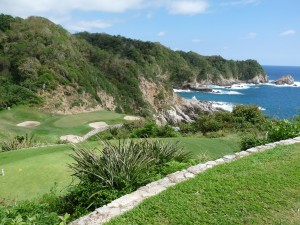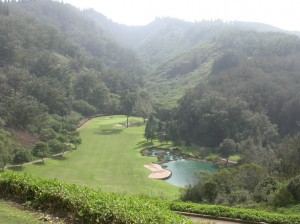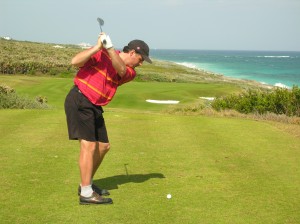Call me fussy (I prefer discerning) but I don’t want to spend my well-deserved winter vacation wearing a tacky plastic bracelet that entitles me to unlimited greasy buffets and watered-down drinks at some all-inclusive resort. Why would I sleep in a cookie-cutter, 2,000-room hotel when I can stay somewhere intimate with tropical style—and where the staff knows my name.
I’ve chased the dimpled white ball over five continents and in doing so I’ve experienced some grand golf. But if I had to name my holy trilogy of destinations where everything—from the courses to the accommodations to the service—rates twenty out of ten, this is it!
It’s a jungle out there and you’re going to love it. My husband and I are living in our own thatched beach casita, one of twenty-nine set in a 2,040-acre resort hideaway about an hour north of Manzanillo. We’re not exactly roughing it. Our casita comes with a private plunge pool, Jacuzzi, hammock, outdoor living room and a beach we share with almost no one.
We might as well have our own private golf course. Counting the two of us, a total of eight golfers signed in yesterday. The only human beings we encounter are minions of maintenance staff the already flawless fairways, our caddy Jorge and the waiter in the snack bar.
However, wildlife abounds. During our rounds we spot wild boars strutting across the eighteenth green and coatimundis (like small long-tailed raccoons) begging for bites of our burgers. We hear tales of a crocodile who lives on number seventeen. Butterflies and wild parrots with exotic plumage flit from tree to tree. Most spectacular is the bird’s eye view of whales breaking the turquoise surf in the jagged cove below the cliffside ninth hole.
Robert Trent Jones Junior originally designed the course. However, owner and ex-banker Roberto Hernandez was so eco-finicky about saving all the trees that California golf course architect David Fleming was brought on site.
“When I started in 1993, it was really wild,” Fleming recalls, “I was nicknamed Indiana Jones and we had amazing adventures with the jaguars, wild boars, sea turtles and parrots. But don’t worry, the dangerous ones don’t golf.”
It took Fleming four months to get the lay of the land and figure out a routing for the holes so as not to disrupt the tree canopy. Each fairway, named after an indigenous plant or animal, is like a private stage. Twelve holes have elevated tees, many with outstanding ocean views.
When asked to name his signature hole, Fleming laughs. “There are about seventeen of them.”
“Numbers six, seven, eight and nine may be the best string of four holes in the world. Before dismissing this as an overstatement, try them,” recommends Golf Odyssey Magazine.
Indeed, six is a stout 472-yard par-four from an elevated tee. On the challenging double dogleg par-five seventh you can try to cut off some of the first dogleg. The short eighth is pure magic, owing to its elevated tee, a long carry over a morass of wild bushes to the fairway far below and a bunker-lined green framed by the sparkling Pacific. The smiling waiter from the halfway house appears with a menu as we sink our putts. Number nine, a breathtaking par-three, plays from a precipitous perch down to a postage-stamp green jutting out over a rousing stretch of untamed, rocky coastline with crashing surf. I’ve instructed my husband that this is where I want my ashes sprinkled when my time comes.
At the halfway house we are refreshed with iced towels perfumed with lemongrass before devouring our burger and fish tacos and a couple of Coronas.
Unlike the “conveyor belt” mentality of many North American courses, this is stress-free, glamour golf. The management encourages you to have a swim between holes. (The pristine beaches are so deserted that even skinny dips are possible.) They’ll also happily cater a picnic on the beach (with washroom and change facilities). Did you par that unforgettable ninth hole? Perhaps you’d like to play it again?
If all this sounds too good to be true, we can thank an elite group of wealthy landowners. At last count, the El Tamarindo real estate development had sold twenty-seven plots of land to these multi-millionaires who pay the golf course maintenance pesos. According to head pro Alejandro Martinez, the management doesn’t really care if there are just a handful of players. In the high season, Martinez acknowledges that El Tamarindo might see forty golfers “on a busy day.”
In sync with the development’s back-to-nature philosophy, spa manager Luz Martinez creates treatments that are “as holistic as possible.” You might opt for a massage in a simple hut on the beach or a seaweed facial, but for something more primordial, try the temascal— a two-and-a-half-hour pre-Hispanic traditional sweat lodge ceremony. It begins with Florentino, the Temascalero, heating hot rocks in a fire outside an igloo-like construction of clay and bricks. We then get into the act by slathering ourselves and each other with healing clay mixed with cucumber, papaya and herbs. Back around the fire, Florentino burns some incense and blows into a conch shell to salute the five directions (north, south, east, west and Earth). Then we sit in a circle inside the temascal, now heated to sauna-like temperatures by the red-hot rocks in a centre pit. Florentino fans the rocks with a broom of lemongrass stalks dripping with herbal water to produce a cleansing steam. We sweat and drink tepid citrus tea while Florentino leads us through this ancient purification ritual involving songs, chants and drumming. After a dip in the sea we’re wrapped in towels and rest on straw mats under a sunset sky tinged with magenta and orange. To say we’re feeling mellow would be an understatement.
Later, we follow a candlelit path to the beachside La Higuera restaurant. We sit under a huge wild fig tree and order a couple of margaritas, flavoured by the tart tamarind fruit for which the resort was named and a bucket of steamed shrimp and contemplate a few more days of playing Tarzan and Jane in this exotic jungle.
The Challenge and The Experience, Lanai, Hawaii
John Travolta flew his family to Lanai on his private jet. A more scenic passage to paradise is to board the Expeditions ferry for the forety-five-minute crossing from Lahaina Harbour on Maui’s west coast. Humpback whales and spinner dolphins escorted my cruise last winter.
Lanai has a fascinating history. In 1922, James Dole bought the entire island and turned it into a pineapple plantation. However, by the late 1980s the pineapple business had become economically unviable. Enter billionaire David Murdock, who purchased ninety-eight percent of the island in 2000 with the intention of returning Lanai back to its natural state. It’s a kind of pineapples to paradise, rags to riches tale.
Among Hawaii-goers the island is almost mythical for its lack of development. You’ll find no traffic lights, no Starbucks and only two sister Four Seasons resorts: The Lodge at Koele and Manele Bay. In 2008, Condé Nast Traveler magazine put both properties on its “World’s Best Places to Stay Gold List.”
For his nuptials, zillionaire Bill Gates reserved the entire 250-room Manele Bay resort and vowed “I do” on the signature twelfth hole of The Challenge at Manele Bay, a cliffside spectacle where the “fairway” is a surging surf forty-five metres below. The camera-shy groom also hired Maui’s entire fleet of helicopters in order to thwart peeping paparazzi.
True to its name, The Challenge, designed by Jack Nicklaus, will test even scratch golfers. Measuring 7,039 yards from the tips, it requires precise tee shots over natural gorges and ravines as it winds precariously along the red rock cliffs on Hulopoe Bay where whales delight in putting on a show.
After surrendering to The Challenge, I head down to the beach, a protected marine reserve where the snorkelling is rated in the world’s best. I have no trouble spotting tropical fish and the pod of dolphins that call these turquoise waters home thanks to topnotch courtesy equipment that includes prescription masks. The beach staff will gladly set up your lounge chair and umbrella, bring you a selection of sunscreens and quench your thirst with some freshly squeezed lemonade.
Later I check into The Spa for some pampering Hawaiian-style, including a cooling Ti Leaf Wrap followed by a rhythmic Lomilomi massage.
Whereas Manele, with its idyllic beach, lush gardens and sunset torch-lighting ceremony, fulfills my stereotypical fantasies about what a resort in paradise should be, guests at the Koele property, about a fifteen-minute shuttle away, will experience a study in contrasts, without sacrificing luxury. The Lodge’s cooler upcountry location and its Great Hall with overstuffed leather chairs and soaring stone fireplaces looks and feels more like a Colorado Mountain Lodge. It’s the ideal antidote for those jet setters jaded by sugar beaches and hula.
The Experience at Koele golf course is also distinctly different from The Challenge. Designed by Greg Norman in collaboration with Ted Robinson, the 7,014 yard track lures players around its pine-covered hills, seven lakes, cascading waterfalls and dramatic gorges. Nowhere are the drastic drops in elevation more memorable than on the signature seventeenth where your tee shot plummets down to a gorge 200 feet below.
With other activities including horseback riding, tennis, archery and sporting clays plus a choice of ten restaurants between the two resorts, there’s really no reason to leave. However, you should check out Lanai City, the island’s only community, with a population of 3,000. Everything here looks pretty much as it did during the plantation days. You’ll find a couple of banks, a church, general store, casual eateries and a tiny movie theatre. It’s like stepping back in time. Do drop into the Hotel Lanai, the island’s original inn, where the Dole pineapple executives used to stay, and sample the inventive cuisine of one of Hawaii’s top chefs, Bev Gannon. On Fridays the hotel offers an enchanting evening of fine cuisine and Hawaiian music presented under a canopy of twinkling stars.
Back for a nightcap at Koele, a tuxedoed gent is tickling the ivories on the grand piano and crooning “I Did It My Way,” Frank Sinatra-style. Regrets? On Lanai you’ll have but few…except having to leave.
The Abaco Club, Bahamas
Entrepreneur and visionary Peter de Savary knows all about location, location, location. The flamboyant Englishman has a knack for finding extraordinary pieces of property (Scotand’s famous Skibo Castle where Madonna got married, for one) and turning them into Edens of extraordinarily good fun.
At the Abaco Club on the island of Abaco in the northern Bahamas, P de S, as he likes to be called, has created a private colony of contentment on more than 530 acres that sweep along Winding Bay. P de S likes to think of it as a castaway kind of place where the luxury is rustic and simple. If I ever have to wash up on a beach, please Neptune, make it here at Winding Bay.
The eighteen-hole golf club, designed by renowned architects Donald Steel and Tom Mackenzie, is touted as the world’s first Scottish-style tropical links. What does that mean? Think palm trees instead of gorse, sunshine instead of fog and teal-blue ocean instead of cold, dark sea. But The Abaco Club does fit the definition of a true links course: it is built on land beside the sea that has been shaped by the wind and it has been designed and maintained to be firm and fast-running. The dunes that dominate many holes would be the envy of some of the greatest seaside links. Prevailing winds are almost always a factor, so hone your bump and run shots.
No offence to Messrs. Steel and Mackenzie, but it would be difficult not to build a great course on this outstanding piece of land that invites walking. The layout is classic: seven holes out, seven back and the final four dramatically perched on Ocean Ridge. Numbers four through seven are seaside showoffs, but it’s the final four that will knock your socks off. There’s a deep quarry to be avoided on fifteen and sixteen. Seventeen is a giddying par-three played from elevated tees down to an oceanside green. The majestic eighteenth starts and ends on a cliff top with the crashing surf on your left and a series of caves on your right. It was at this point that former Toronto Star travel editor Marc Atchison looked to the heavens and said, “Take me now Lord, because it can’t get much better than this!”
Many of the pros concur. Members include Ernie Els, Annika Sorenstam, Darren Clarke, Lee Westwood and Greg Norman. Sir Sean Connery, who christened the course, deemed it “a perfect jewel of a design.”
Not that you’d ever tire of this golf course but there are other sporting options. Those ridiculously blue waters are renowned for bone fishing. The snorkeling is superb. In fact, that’s usually how Abaco’s golf director, Justine Norvell, often starts his day. No wonder he’s in such a jolly mood when he appears at the twelfth hole with frosty glasses of rum punch. “You’ll need this for the last seven,” he winks.
As the sun sets, guests usually sink their toes into the sand and order a Bahamian cocktail at Busters Beach Bar, where the ambiance might be described as rustic Robinson Crusoe. Later we gather for dinner in the octagonal-shaped Clubhouse, a casual spot with a million-dollar view of Winding Bay. Fresh seafood such as champagne shrimp cocktail and orange-grilled spiny lobster are amongst the dishes served up by the chefs in the open kitchen. And believe me, the wine list isn’t shabby. Alas, tomorrow we leave this bit of Bahamian heaven, so best to savour it to the max.
As is it a private club, prospective new owners and members are invited to visit once to decide if they want to invest in real estate here. We stayed in the cabana cottages along the first fairway, but there are also cottages and one estate home in the rental program. Unless I win a lottery, though, this might well be a once-in-a-lifetime experience.
Contacts
El Tamarindo, a member of Mexico Boutique Hotels, is located about forty-eight kms north of Manzanillo International Airport and 209 kms south of Puerto Vallarta. Once you turn off the highway at the sign, follow the cobblestone road though the jungle for about twenty minutes. Don’t give up; there really is paradise at the end of the road.
Guests of Four Seasons Manele Bay and Lodge at Koele enjoy signing privileges at both properties. The Four Seasons shuttle will pick you up and deliver you back to the Lanai airport or ferry. www.fourseasons.com
You can fly via Island Air (www.islandair.com) or take the Expeditions Ferry (www.go-lanai.com).
For tourist information, visit www.islandoflanai.com.
The Abaco Club is managed by Ritz-Carlton. A private shuttle picks you up at the airport and takes you to the club where guests are given their own golf carts to travel around the property. The private reserve consists of home sites, cottages, cabanas, clubhouse, spa, tennis courts, equestrian centre, fishing club and golf course.
Abaco enjoys scheduled non-stop air service to Marsh Harbour Airport from Miami, West Palm Beach, Ft. Lauderdale and Nassau. The Abaco Club can also arrange for transport in a Fairchild Merlin IV-C twin turbo prop that seats up to twelve.



